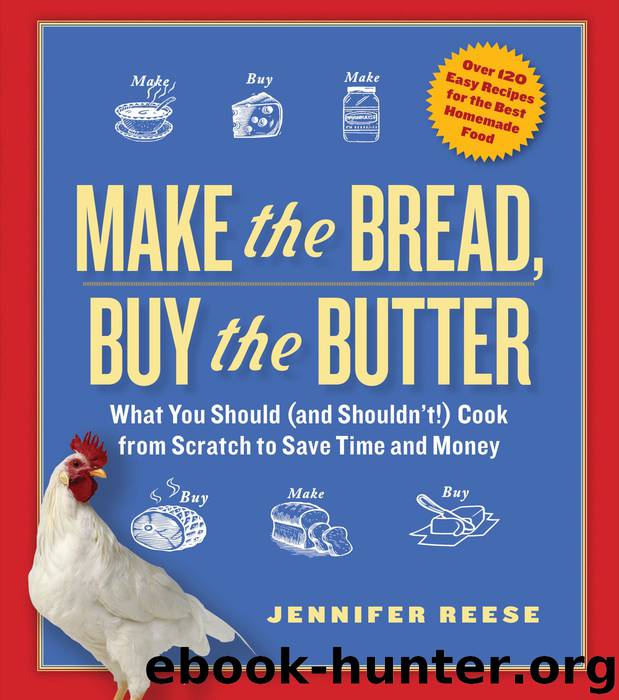Make the Bread, Buy the Butter: What You Should and Shouldn't Cook From Scratch -- Over 120 Recipes for the Best Homemade Foods by Jennifer Reese

Author:Jennifer Reese [Reese, Jennifer]
Language: eng
Format: epub
ISBN: 9781451605877
Amazon: B004T4KXMS
Goodreads: 11510733
Publisher: Atria Books
Published: 2011-10-17T23:00:00+00:00
Makes 1 quart
CHAPTER 9
FRUIT
For the chickens, for the $163 seed bill, for the whole ramshackle barnyard that I can see from my bedroom window, I blame an apple tree. Or credit an apple tree. I still don’t know which. That apple tree, it gave me ideas.
When Mark and I were first married, we rented a house in the foggiest neighborhood in San Francisco, a famously foggy city. Whole summers went by and we did not see the sun. As the puckish San Francisco Chronicle columnist Herb Caen once put it, “There wasn’t a sky in the cloud.” Rather than sod lawns in front of their houses, people in our neighborhood sometimes just poured cement and painted it pink or green. It was like living on the moors of Great Britain with painted concrete instead of heath, the desolation punctuated by Chinese grocery stores instead of taverns. For a long time, we wanted to live nowhere else. Then, when we had two children, we decided we wanted to buy a house. Our decision to move to the suburbs had nothing to do with crime, home prices, parking spots, or family values. I thought, If we stay here inside the cloud with the pink and green concrete, we will never, in our entire lives, grow a garden. I had no reason to believe that I would even like gardening, but as we all know, the Garden is symbolic.
We decided to move to Mill Valley, a sunny town just north of San Francisco where Cyra McFadden set her 1970s satiric classic The Serial, about the misadventures of some spouse-swapping, pot-smoking, middle-class men and women who aren’t quite as groovy as they want to be. The realtor who sold us our house was named George, and Mark and I thought George had probably enjoyed some wife swapping and pot smoking in his day. We underestimated his cunning. He took us in at a glance—pale, anxious young city people in search of their Garden—and drove us straight to a house well outside of our price range. He looked me in the eye and, standing there in front of a too-small 1960s faux Tudor on a steep hill, pointed out the apple tree that grew against the cement stucco south wall. I didn’t see the cement stucco, only the tree. He twisted an apple off a bough and sank his teeth into it. I realize now that the apple could not have been ripe—it was midsummer and those fruits don’t mature until September—but George betrayed nothing. Although it stretched our finances thin as phyllo dough and I had to persuade, cajole, seduce, and bully Mark into the purchase, and later take the blame whenever anything broke or rattled or leaked, which it did, we bought that apple tree.
Our tree is a Melrose apple—a cross between a Jonathan and a Red Delicious—and its branches weep under a load of red-striped fruit every September. There’s a reason Shel Silverstein did not call his book The Giving Pea Vine, or The Giving Turnip Plant.
Download
This site does not store any files on its server. We only index and link to content provided by other sites. Please contact the content providers to delete copyright contents if any and email us, we'll remove relevant links or contents immediately.
Periodization Training for Sports by Tudor Bompa(8170)
The Body: A Guide for Occupants by Bill Bryson(4974)
The MacArthur Bible Commentary by John MacArthur(4749)
The Sports Rules Book by Human Kinetics(4294)
What It Really Takes to Get Into Ivy League and Other Highly Selective Colleges by Hughes Chuck(3696)
Marijuana Grower's Handbook by Ed Rosenthal(3623)
The Sprouting Book by Ann Wigmore(3543)
The Martian by Andy Weir(3308)
Salt, Fat, Acid, Heat: Mastering the Elements of Good Cooking by Nosrat Samin(3108)
The Bread Bible by Rose Levy Beranbaum(3004)
Harry Potter 4 - Harry Potter and The Goblet of Fire by J.K.Rowling(2990)
Sapiens and Homo Deus by Yuval Noah Harari(2987)
The Marketing Plan Handbook: Develop Big-Picture Marketing Plans for Pennies on the Dollar by Robert W. Bly(2975)
Classic by Mary Berry(2942)
Martha Stewart's Baking Handbook by Martha Stewart(2796)
Screenplay: The Foundations of Screenwriting by Syd Field(2574)
The Plant Paradox by Dr. Steven R. Gundry M.D(2547)
50 Economics Classics by Tom Butler-Bowdon(2523)
The Cambridge Grammar Of The English Language by Rodney Huddleston Geoffrey K. Pullum(2382)
